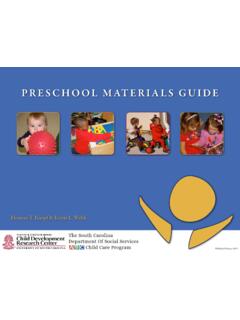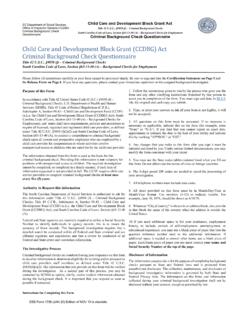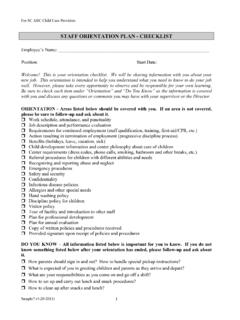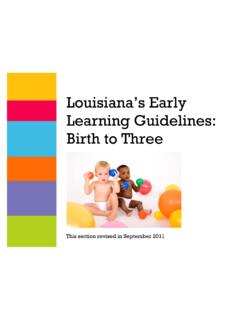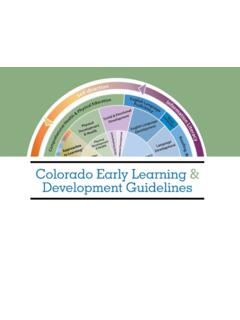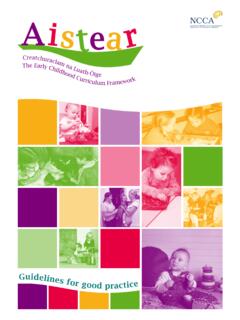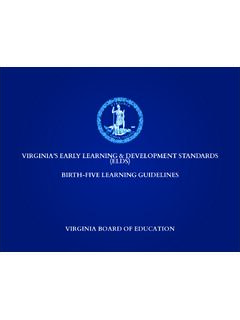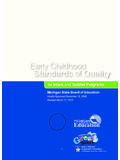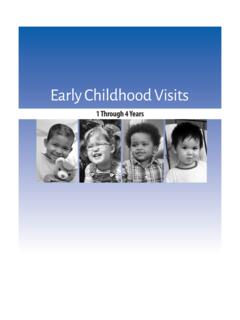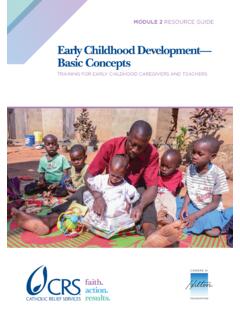Transcription of Early Learning Standards - SC Child Care
1 South Carolina Early Learning StandardsSouth Carolina Early Learning Standards 2017. South Carolina Early Learning Standards Interagency Stakeholder Group. CO-CHAIRS, SC-ELS INTERAGENCY STAKEHOLDER GROUP Noelle McInerneyDivision of Early Care and Education South Carolina Department of Social ServicesPenny DanielsonOffice of Early Learning and Literacy South Carolina State Department of Education WRITERSMeir MullerCollege of Education University of South CarolinaNancy Freeman, Professor EmeritaCollege of EducationUniversity of South CarolinaEDITORS Beverly HunterDivision of Early Care and Education South Carolina Department of Social Services Jennifer AndersonOffice of Early Learning and LiteracySouth Carolina State Department of EducationMANAGERA ngela BaumCollege of EducationUniversity of South CarolinaDESIGNERC hristopher SleemePropulsion SquaredThe South Carolina Early Learning Standards may be freely reproduced without permission for non-profit, educational versions of this report are available from the following websites: citation: South Carolina Early Learning Standards Interagency Stakeholder Group.
2 (2017). South Carolina Early Learning Standards . Columbia: AuthorFunding for this document was provided by the South Carolina Department of Social Services using federal funds from the Office of Child Care, Administration for Children and Families, Department of Health and Human Services and the South Carolina Head Start Collaboration Office using federal funds from the Office of Head Start, Administration for Children and Families, Department of Health and Human ServicesThis document was adapted from The North Carolina Foundations for Early Learning and Development with permission from the North Carolina Division of Child Development and Early Education and the North Carolina Department of Public Carolina Early Learning Standards3 TABLE OF CONTENTSA cknowledgementsOrganization of This DocumentUsing the Goals and Developmental IndicatorsDomains, Subdomains, and Goals OverviewDomains of DevelopmentApproaches to Play and Learning (APL)Emotional and Social Development (ESD)Health and Physical Development (HPD)Language Development and Communication (LDC)Mathematical Thinking and Expression (MTE)Cognitive Development (CD)AppendixSC-ELS Interagency Leadership TeamSC-ELS Interagency Stakeholders GroupUnderstanding the South Carolina Early Learning StandardsHow to Use the South Carolina Early Learning StandardsSuccess in SchoolFrequently Asked QuestionsCitations and Resources4610111735537310111714114114414 8153159162 APLESDHPDLDCMTECDS outh Carolina Early Learning Standards4 ACKNOWLEDGEMENTSIn 2013, the South Carolina State Child Care Administrator s Office at the Division of Early Care and Education in the SC Department of Social Services (SCDSS)
3 Authorized and funded the revision of the Infant-Toddler guidelines and the Good Start, Grow Smart Early Learning Standards . That effort led to the creation of the South Carolina Early Learning Standards (SC-ELS) a single document that describes children s development and Learning from birth to age five. The Division of Early Care and Education and the Office of Early Learning and Literacy in the South Carolina Department of Education (SCDE) provided co-leadership for this initiative and have contributed critical advice, oversight, and vision on the ELS and its implementation. Many individuals from across the state devoted their time and expertise to this task force. We are grateful to everyone s work on this important resource for our Standards are based on the North Carolina Foundations for Early Learning and Development. We thank the North Carolina Division of Child Development and Early Education and the North Carolina Department of Public Instruction for granting South Carolina their permission to rely heavily on their work in the development of this resource.
4 These South Carolina Standards differ from the North Carolina Foundations for Early Learning and Development in that they include Mathematical Thinking and Expression as a separate domain. Thank you to Mary Ruzga, Mathematics Education Associate, from the Office of Standards and Learning at the SCDE and Sandra Linder, Associate Professor of Early Mathematics at Clemson University for guidance in the math domain. This publication is dedicated to South Carolina s Early childhood professionals and the teachers who nurture and support the development of many young children who are in school or in care while their families EXPERT CONSULTANTSS haron Lynn KaganVirginia and Leonard Marx Professor of Early Childhood and Family Policy, Teacher s College, Columbia University Catherine Scott-LittleAssociate Professor of Human Development and Family Studies, University of North Carolina at GreensboroSouth Carolina Early Learning Standards5 SOUTH CAROLINA Early Learning Standards EXECUTIVE COMMITTEEJ ennifer AndersonDirector, Office of Early Learning and Literacy South Carolina State Department of EducationAngela BaumAssociate Professor of Early Childhood Education University of South CarolinaPenny Danielson, ELS Revision Co-Chair Team Lead.
5 Child Development Educational Program South Carolina State Department of EducationNancy Freeman, Co-writer Professor Emerita University of South CarolinaBeverly Hunter, Project ManagerProgram Manager, ABC Quality Rating and Improvement System, Division of Early Care and Education, SCDSSN oelle McInerney, ELS Revision Co-Chair Program and Policy Lead, Division of Early Care and Education South Carolina Department of Social ServicesMeir Muller, Lead WriterClinical Assistant Professor of Early Childhood EducationUniversity of South CarolinaPrincipal, Cutler Jewish Day School Also serve as members of the SC-ELS Interagency Leadership Team and Stakeholder GroupPUBLIC COMMENTThe team provided opportunities for public comment on the South Carolina Early Learning Standards (SC-ELS) from May 6, 2016 to May 22, 2016; September 9, 2016 to October 10, 2016; and from February 1, 2017 to February 15, 2017.
6 Feedback was received from over 200 individuals including teachers of infants, toddlers, and 2-year olds; 3K, 4K, and 5K teachers from public and private settings; teachers of children in grades 1-4; Head Start administrators; public school and district-level administrators; directors of Child care programs; literacy, instructional, and reading coaches; higher education faculty members; and parents and grandparents of young children. South Carolina Early Learning Standards6 ORGANIZATION OF THIS DOCUMENTThe SC-ELS Goals and Developmental Indicators describe expectations for what children will learn, starting with infancy and covering all ages through kindergarten entry. The Goals and Developmental Indicators are divided into six domains: Approaches to Play and Learning (APL) Emotional and Social Development (ESD) Health and Physical Development (HPD) Language Development and Communication (LDC) Mathematical Thinking and Expression (MTE) Cognitive Development (CD)All six of the domains are essential components in the SC-ELS because all children develop differently.
7 All domains are equally important and overlap is to be expected. The overlap is needed because children s development and Learning are integrated or interrelated. The progress that a Child makes in one domain is related to the progress he or she makes in other domains. For example, as a Child interacts with adults ( , Social Development), she/he learns new words ( , Language Development) that helps her/him understand new concepts ( , Cognitive Development). Therefore, it is essential that the SC-ELS address all six domains, and that teachers and caregivers who use the SC-ELS realize that all six domains are related and should not be considered independently from one another. A Domain Introduction is located at the beginning of each domain section. The introduction describes some of the most important ideas related to the domain. This introductory information provides understanding of children s Learning and development.
8 The introduction is followed by the Goal and Developmental Indicator Continuum (sometimes called a Continuum in this document) for each domain. The Continuum for each domain shows the Goals (statements that describe a general area or aspect of development that children make progress on from birth to age five) for the domain, and the Developmental Indicators (more specific statements of expectations for children s Learning and development that are tied to age levels). As the following sample shows, South Carolina has elected to arrange the Developmental Indicators along a continuum so that the Developmental Indicators for the age levels from birth to kindergarten entry are included. This format allows teachers and caregivers to easily look across the age levels to see the progression that a Child might make toward the Goal. The Goals are organized in Subdomains or subtopics that fall within the domain, with one or more Goal and Developmental Indicator Continua for each subdomain.
9 Developmental Indicator ContinuumGenerally, the Developmental Indicators describe expectations that many children will reach toward the end of their respective age level. They are not, however, hard and fast requirements or expectations for what children should be able to do at the end of the age level. The fact that there is some overlap across the age levels shows that what children know and can do at one age is closely related to what they know and can do at the previous and the next age level. Most children will reach many, but not necessarily all, of the Developmental Indicators that are listed for their age level; some will exceed the Developmental Indicators for their age level well before they are chronologically at the upper end of the age range; and others may never exhibit skills and knowledge described for an age level. The Goal and Developmental Indicator Continua are designed to help teachers and caregivers identify where an individual Child might be on the Learning continuum described in the Developmental Indicators, and to easily see what might have come before and what might come after the Child s current level of development.
10 In limited instances, developmental indicators can be observed more broadly in multiple age levels. When this occurs, an arrow is used to show that the developmental indicator occurs across multiple age Carolina Early Learning Standards7 The Developmental Indicators are numbered so that it is easier to find specific items. The numbering system is the same for all Developmental Indicators across all six domains. First, there is an abbreviation of the domain where the Developmental Indicator is found (APL for Approaches to Play and Learning in the following sample chart). The abbreviation is followed by a number that indicates what Goal the Developmental Indicator is associated with (1 for Goal 1 in the sample chart). Each of the Developmental Indicators for each Goal has a letter that reflects the order of the item. The first indicator in the infant age level begins with the letter a, the second indicator begins with the letter b, etc.
